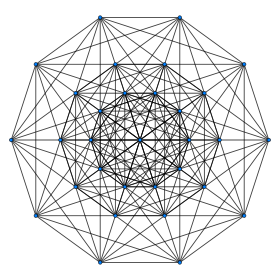1 33 honeycomb
| 133 honeycomb | |
|---|---|
| (no image) | |
| Type | Uniform tessellation |
| Schläfli symbol | {3,33,3} |
| Coxeter symbol | 133 |
| Coxeter-Dynkin diagram | or |
| 7-face type | 132 |
| 6-face types | 122 131 |
| 5-face types | 121 {34} |
| 4-face type | 111 {33} |
| Cell type | 101 |
| Face type | {3} |
| Cell figure | Square |
| Face figure | Triangular duoprism |
| Edge figure | Tetrahedral duoprism |
| Vertex figure | Trirectified 7-simplex |
| Coxeter group | , [[3,3<sup>3,3</sup>]] |
| Properties | vertex-transitive, facet-transitive |
In 7-dimensional geometry, 133 is a uniform honeycomb, also given by Schläfli symbol {3,33,3}, and is composed of 132 facets.
Construction
It is created by a Wythoff construction upon a set of 8 hyperplane mirrors in 7-dimensional space.
The facet information can be extracted from its Coxeter-Dynkin diagram.
Removing a node on the end of one of the 3-length branch leaves the 132, its only facet type.
The vertex figure is determined by removing the ringed node and ringing the neighboring node. This makes the trirectified 7-simplex, 033.
The edge figure is determined by removing the ringed nodes of the vertex figure and ringing the neighboring node. This makes the tetrahedral duoprism, {3,3}×{3,3}.
Kissing number
Each vertex of this polytope corresponds to the center of a 6-sphere in a moderately dense sphere packing, in which each sphere is tangent to 70 others; the best known for 7 dimensions (the kissing number) is 126.
Geometric folding
The group is related to the by a geometric folding, so this honeycomb can be projected into the 4-dimensional demitesseractic honeycomb.
| {3,33,3} | {3,3,4,3} |
E7* lattice
contains as a subgroup of index 144.[1] Both and can be seen as affine extension from from different nodes: ![]()
The E7* lattice (also called E72)[2] has double the symmetry, represented by [[3,3<sup>3,3</sup>]]. The Voronoi cell of the E7* lattice is the 132 polytope, and voronoi tessellation the 133 honeycomb.[3] The E7* lattice is constructed by 2 copies of the E7 lattice vertices, one from each long branch of the Coxeter diagram, and can be constructed as the union of four A7* lattices, also called A74:
-








 ∪
∪ 







 =
= 







 ∪
∪ 







 ∪
∪ 







 ∪
∪ 







 = dual of
= dual of 







 .
.
Related polytopes and honeycombs
The 133 is fourth in a dimensional series of uniform polytopes and honeycombs, expressed by Coxeter as 13k series. The final is a noncompact hyperbolic honeycomb, 134.
| Space | Finite | Euclidean | Hyperbolic | |||
|---|---|---|---|---|---|---|
| n | 4 | 5 | 6 | 7 | 8 | 9 |
| Coxeter group |
A3A1 | A5 | D6 | E7 | =E7+ | =E7++ |
| Coxeter diagram |
||||||
| Symmetry | [3−1,3,1] | [30,3,1] | [31,3,1] | [32,3,1] | [[3<sup>3,3,1</sup>]] | [34,3,1] |
| Order | 48 | 720 | 23,040 | 2,903,040 | ∞ | |
| Graph |  |
 |
 |
- | - | |
| Name | 13,-1 | 130 | 131 | 132 | 133 | 134 |
Rectified 1_33 honeycomb
The rectified 133 or 0331, Coxeter diagram ![]()
![]()
![]()
![]()
![]()
![]()
![]()
![]()
![]() has facets
has facets ![]()
![]()
![]()
![]()
![]()
![]()
![]()
![]()
![]() and
and ![]()
![]()
![]()
![]()
![]()
![]()
![]() , and vertex figure
, and vertex figure ![]()
![]()
![]()
![]()
![]()
![]()
![]() .
.
See also
Notes
- ↑ N.W. Johnson: Geometries and Transformations, (2015) Chapter 12: Euclidean symmetry groups, p 177
- ↑ http://www.math.rwth-aachen.de/~Gabriele.Nebe/LATTICES/Es7.html
- ↑ The Voronoi Cells of the E6* and E7* Lattices, Edward Pervin
References
- H.S.M. Coxeter, Regular Polytopes, 3rd Edition, Dover New York, 1973
- Coxeter The Beauty of Geometry: Twelve Essays, Dover Publications, 1999, ISBN 978-0-486-40919-1 (Chapter 3: Wythoff's Construction for Uniform Polytopes)
- Kaleidoscopes: Selected Writings of H.S.M. Coxeter, edited by F. Arthur Sherk, Peter McMullen, Anthony C. Thompson, Asia Ivic Weiss, Wiley-Interscience Publication, 1995, ISBN 978-0-471-01003-6
- (Paper 24) H.S.M. Coxeter, Regular and Semi-Regular Polytopes III, [Math. Zeit. 200 (1988) 3–45]
| Fundamental convex regular and uniform honeycombs in dimensions 3–10 (or 2-9) | |||||
|---|---|---|---|---|---|
| Family | / / | ||||
| Uniform tiling | {3[3]} | δ3 | hδ3 | qδ3 | Hexagonal |
| Uniform convex honeycomb | {3[4]} | δ4 | hδ4 | qδ4 | |
| Uniform 5-honeycomb | {3[5]} | δ5 | hδ5 | qδ5 | 24-cell honeycomb |
| Uniform 6-honeycomb | {3[6]} | δ6 | hδ6 | qδ6 | |
| Uniform 7-honeycomb | {3[7]} | δ7 | hδ7 | qδ7 | 222 |
| Uniform 8-honeycomb | {3[8]} | δ8 | hδ8 | qδ8 | 133 • 331 |
| Uniform 9-honeycomb | {3[9]} | δ9 | hδ9 | qδ9 | 152 • 251 • 521 |
| Uniform 10-honeycomb | {3[10]} | δ10 | hδ10 | qδ10 | |
| Uniform n-honeycomb | {3[n]} | δn | hδn | qδn | 1k2 • 2k1 • k21 |